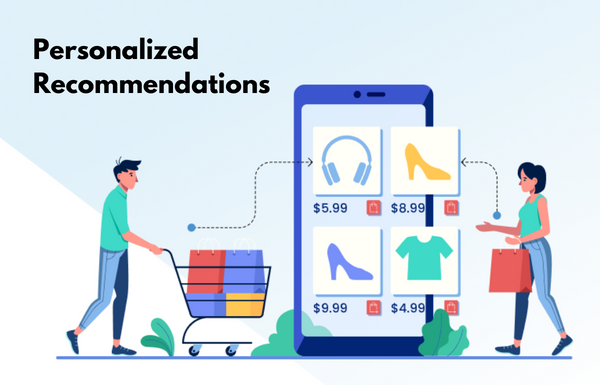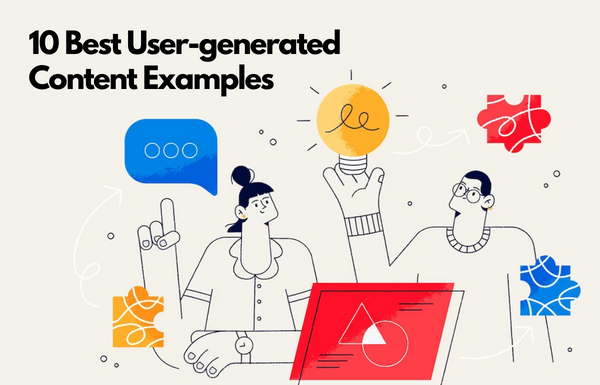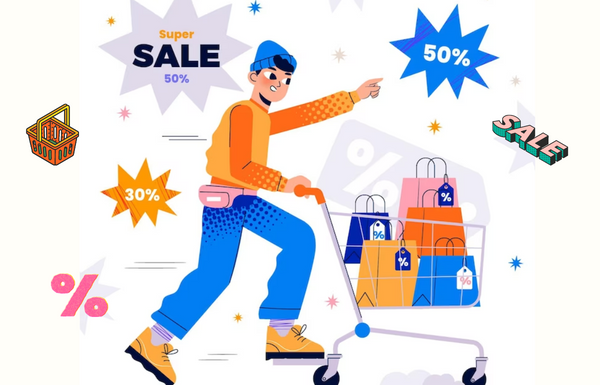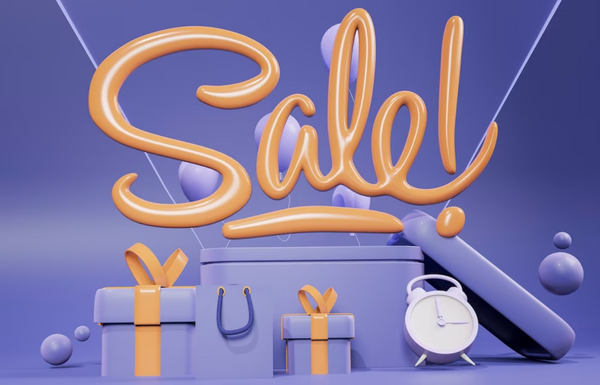Have you ever noticed how online platforms like Amazon, Netflix, or Spotify seem to know exactly what you want, even before you perform any action? It’s not magic, but the power of personalized recommendations.
Personalized recommendations have become a universal feature of our online lives, especially for eCommerce websites. By analyzing the browsing and purchase histories, these online stores can make targeted product suggestions, ultimately driving repeat purchases and increasing customer loyalty.
In this blog, we’ll explore how personalized recommendations work, and how you can use them to enhance your customer shopping experience as well as boost your sales. So, get ready to learn how to leverage the power of a personalized recommendation engine to drive frequent sales and keep your customers coming back for more.
Let’s start with the basics!
What are Personalized recommendations?

In eCommerce, personalized recommendations are tailored suggestions that use the browsing history and purchase of the shopper’s history to suggest products or content that align with your interests and preferences. These recommendations are the driving force behind increased customer engagement, repeat purchases, and improved customer loyalty.
How personalized recommendations work?
You might be thinking of it as magic, but there is a lot of science behind it!
In fact, the credit behind personalized recommendations goes to the smart algorithms that analyze user interactions, behavior, and preferences with the website. This is typically done using a combination of data such as previous purchases, search history, and even things like demographic information.
For example,
- Collaborative filtering systems compare your habits with those of other users to uncover patterns and similarities that inform your personalized recommendations.
- Content-based filtering systems focus on the characteristics of the products or content you have interacted with to suggest similar items.
The algorithms then use this data to generate recommendations that are unique to each customer, making their shopping experience more personalized and enjoyable.
Examples of personalized recommendations

With personalized recommendations, the possibilities are endless! It’s like having a personal shopping assistant who knows your style better than anyone else.
Here are some inspiring examples of personalized recommendations:
- Suggesting the perfect pair of shoes to match your recently brought dress.
- Discovering a new favorite book based on your past purchases.
- Dynamic pricing that offers personalized discounts and deals based on customer behavior.
- Offering “You may also like” suggestions using advanced machine learning techniques.
- Personalized product recommendations based on social media activity and interests.
- Offering personalized meal combos based on individual customer preferences.
Now, let’s go through the major benefits of personalized recommendations!
Benefits of Personalized Recommendations
By using data analytics and machine learning algorithms, online merchants can generate various relevant recommendations tailored to each individual’s interests and preferences.
This approach has several benefits for both the store owners and their customers.
For online store owners
1. Increased Sales
Forbe says Amazon’s recommendation engine helped the company increase sales by 35%. By suggesting products that are relevant to customers’ interests and needs, online stores can encourage customers to make more purchases.
2. Improved Customer Retention

Customers are more likely to purchase products from a store where they find suitable products without much hassle. There are many ways personalized recommendations can help build stronger relationships with customers, leading to higher retention rates.
3. Enhanced Customer Experience
Personalized recommendations create a more engaging and personalized shopping experience for customers. This can increase customer satisfaction and loyalty, as well as positive word-of-mouth recommendations.
4. Data Insights
Personalized recommendations generate valuable data insights that can help online store owners improve their business operations. This data can help online store owners make more informed decisions about product offerings, promotions, and marketing strategies.
For the customer
1. Personal Shopping Assistant

Everyone seeks a shopping partner who knows their taste and helps them get suitable stuff. Personalized recommendations can create a more enjoyable and personalized shopping experience for customers. Customers can quickly find products that meet their needs without having to search through irrelevant products.
2. Time-saving
No more endless scrolling through countless products!
Recommendations that are tailored to customers’ interests and preferences save time by presenting them with the products they are actually looking for. It can save customers time by suggesting products that meet their needs.
3. Boost Satisfaction
It provides a personalized touch to their shopping experience, making customers feel valued and appreciated. It’s like having a shopping buddy who knows your every desire and needs, leading to more diverse and satisfying shopping experiences.
Now that you know what are the benefits of implementing personalized recommendations in your online store. Now it’s time for the most awaited part of the blog!
Best Personalized Recommendation Strategies
By providing customers with personalized recommendations, you can improve the customer experience, increase customer loyalty, and ultimately drive sales.
So let’s check out the best personalized recommendation methods to boost your sales and revenue!
1. Personalized Product Recommendations

Have you ever noticed how Amazon suggests products based on your previous purchases? This is about suggesting products your customers are more likely to be interested in.
When it comes to personalized product recommendations, you have lots of options and opportunities to offer product recommendations to your shoppers. This approach is especially useful for online stores that have a vast catalog of products, making it challenging for customers to find what they need.
Here are the most useful ways to offer personalized product recommendations in your store:
- “Frequently Bought Together” Products: Suggest products that are commonly purchased together with the item the customer is currently viewing.
- Personalized Product Bundles: Create product bundles based on the customer’s previous purchase history or browsing behavior.
- Similar Product Recommendations: Suggest products that are similar to the item the customer is currently viewing based on attributes such as color, material, style, or price range.
- Recently Viewed Items: Show customers a list of products they recently viewed on the site to remind them of items they might have forgotten about or to encourage them to make a purchase.
- Popular Products: Display products that are currently popular among other customers or have high ratings and reviews.
- Cross-Sell Recommendations: Recommend complementary products to the customer’s purchase or interests, such as suggesting a matching accessory or a related product.
- Loyalty Rewards: Offer personalized product recommendations based on the customer’s loyalty level, such as suggesting exclusive products or discounts.
- Wishlist Recommendations: Recommend products that are similar to items that the customer has added to their wishlist or items they have previously purchased.
There are many places where you can use the above personalized product recommendations such as the homepage, product pages, product category page, cart page, and more. Choose the page as well as the position on the page wisely for better results.
2. Personalized Deals

Everyone loves a good deal, but personalized deals? That’s the next level.
By offering amazing discounts and promotions based on your customer’s interests, you’ll be giving them a reason to hit that “Add to cart” button faster!
For example, if a customer has been browsing a certain category of products but hasn’t made a purchase yet, you could offer them a personalized discount to incentivize them to complete the purchase.
Here are some ideas for creating personalized deals or offers in online stores:
- First-Time Customer Discounts: Offer a discount code to new customers who make their first purchase on the site.
- Abandoned Cart Offers: Send personalized discount offers to customers who leave items in their cart without making a purchase to encourage them to complete the transaction.
- Loyalty Rewards: Offer special discounts or deals to loyal customers, such as free shipping, exclusive sales, or early access to new products.
- Birthday Discounts: Offer personalized discount codes or gift cards to customers on their birthdays to make them feel special and encourage them to make a purchase.
- VIP Offers: Provide exclusive deals or discounts to VIP customers, such as customers who have made a certain number of purchases or have a high average order value.
- Location-Based Offers: Provide deals or promotions based on the customer’s location or the location of the nearest store to encourage local customers to make a purchase.
- Purchase History Offers: Provide personalized deals or promotions based on the customer’s purchase history to incentivize them to buy related products.
- Email Sign-Up Offers: Provide discounts or promotions to customers who sign up for the store’s email newsletter to encourage them to make a purchase and stay engaged with the brand.
Personalization in offers boosts its effectiveness. So, sit with your team and brainstorm personalized deals for your shoppers!
3. Dynamic Pricing

Have you noticed the price of some products changes when you visit the site on different days?
It’s about adjusting product prices in real-time based on customer behavior and market conditions. This can be done using machine learning algorithms that analyze data such as customer purchase history, competitor pricing, and market demand to set prices that are optimized for each customer.
Here are some ideas for implementing dynamic pricing in online stores:
- Time-Based Pricing: Offer different prices for products depending on the time of day, day of the week, or season to reflect changes in demand and supply.
- Location-Based Pricing: Offer different prices for products depending on the customer’s location, shipping destination, or local market conditions.
- Customer-Based Pricing: Offer different prices for products based on the customer’s purchase history, loyalty level, or other demographic information.
- Cart-Based Pricing: Offer discounts or promotions based on the total value of items in the customer’s shopping cart to incentivize larger purchases.
- Dynamic Discounted Pricing: Offer discounts or promotions that automatically adjust based on the customers’ behavior, such as adding more items to their cart or abandoning their cart.
- Tiered Pricing: Offer different prices for products based on the quantity purchased, such as offering a lower price per unit for larger orders.
- Dynamic Shipping Pricing: Offer different shipping options with varying prices depending on the customer’s location, shipping destination, or shipping speed.
This way you can offer different prices for services based on factors such as time of day, availability, or demand.
4. Personalized Reminder Emails

Sometimes customers get distracted or busy and abandon their shopping cart or leave your website without making a purchase.
By using customer data, you can create tailored emails that remind customers of the items they left in their cart or suggest products they might be interested in based on their browsing and purchase history. This strategy can help recover lost sales and improve customer engagement.
Let’s see the best ideas to send personalized reminder emails to customers!
- Abandoned Cart Reminder: Mail the customers who have abandoned their cart, reminding them of the items they left behind and encouraging them to complete the purchase.
- Wishlist Reminder: Mail the customers who have added items to their wishlist, reminding them of the products they showed interest in and encouraging them to make a purchase.
- Loyalty Program Reminder: Mail the customers who are close to reaching the next level of your loyalty program, reminding them of the rewards they can earn and encouraging them to make additional purchases.
- Replenishment Reminder: Mail the shoppers to repurchase a product that they previously bought and offer related products or promotions.
- Event Reminder: Send a personalized email to subscribers who have RSVP’d for an event, reminding them of the event details and encouraging them to attend.
- Product Review Reminder: Mail the customers who have recently purchased a product, reminding them to leave a review and providing a link to the review page.
- Seasonal Reminder: Mail the buyers during seasonal periods, reminding them of relevant products and promotions.
- Birthday Reminder: Send a special promotion or discount to celebrate their special day.
- Subscription Renewal Reminder: Mail the buyers who are close to the end of their subscription period, reminding them to renew their subscription.
- Post-Purchase Reminder: Send an email to customers after they make a purchase reminding them of related products or accessories that complement their recent purchase.
- Inactivity Reminder: Mail the shoppers who have not made a purchase in a while, offering a special promotion or discount to encourage them to return to the site and make a purchase.
I guess you’re already using some of these emails for your online shoppers. If not, you should start it immediately to see a rise in your sales.
5. On-site Targeting Customers

Why play hard to get when you can give customers exactly what they want?
On-site customer targeting involves using customer data and behavior to personalize their shopping experience while they’re browsing your website. This can include displaying personalized product recommendations, special offers, or even pop-up messages based on the customer’s behavior.
For example, if a customer spends a lot of time on a particular product page, you can display a pop-up message offering a discount on that product to entice them to make a purchase.
Here are some ideas for targeting site visitors:
- Exit Intent Pop-ups: Show a pop-up message to customers who are about to leave the site, offering a discount or promotion to encourage them to stay and make a purchase.
- In-page Pop-ups: Display a pop-up message on the product page or during checkout, offering a discount or promotion to encourage the customer to make a purchase.
- Countdown Timers: Add a countdown timer for limited-time offers or promotions to create a sense of urgency and encourage customers to make a purchase.
- Abandoned Cart Notifications: Send notifications to customers who abandoned their shopping cart, reminding them of the items left behind and offering a discount or promotion to encourage them to complete the purchase.
- Live Chat: Provide a live chat option for customers to ask questions or get assistance with their purchases, which can help increase conversion rates and improve customer satisfaction.
- Gamification: Add quizzes, contests, or rewards programs to engage customers and encourage them to make a purchase.
Make sure not to overload your website with these elements; otherwise, it can ruin the shopping experience for your customers.
6. Upselling and Cross-Selling

Selling products is great, but selling more products is even better. With upselling and cross-selling, you’ll be recommending complementary or higher-end products to customers based on their purchase history and browsing behavior.
For example, if a customer is purchasing a camera, you can suggest additional lenses or accessories that complement their purchase. This can help increase the average order value and improve customer satisfaction by providing them with a more complete solution.
Here are some ideas for upselling and cross-selling in online stores:
- Related Products: Display related products or accessories that complement the customer’s current purchase, either on the product page or in the shopping cart.
- Upgrade Offers: Offer customers the option to upgrade to a higher-priced or more advanced version of the product they are considering.
- Customized Bundles: Allow customers to create their own customized bundles of products, encouraging them to purchase additional items and increasing the likelihood of cross-selling.
- Cross-Category Selling: Encourage customers to purchase items from different categories by showcasing products that may interest them based on their purchase history or browsing behavior.
- Subscription Services: Offer a subscription for products they regularly purchase, such as monthly refills of a consumable item.
These strategies will help you build customer loyalty, increase customer engagement, and drive more sales, making them essential for any eCommerce store looking to stay competitive in today’s market.
Wrapping Up!
In a nutshell, personalized recommendations is a must-have tool for eCommerce businesses looking to boost customer engagement and drive repeat purchases.
By analyzing user behavior and preferences, personalized recommendations offer targeted product or content suggestions that are tailor-made for each individual. With the power of advanced recommendation engines, businesses can enhance the customer experience, increase customer loyalty, and ultimately boost sales.
So if you’re looking to take your business to the next level, consider investing in personalized recommendations. By leveraging data-driven insights, businesses can offer a customer experience that feels personal and relevant, creating a lasting connection with their customers.
Hope this blog helped you to explore the world of personalized recommendations. Now it’s time to unlock the higher revenues in your online business using personalized recommendations.
If you have a Shopify store and want to implement personalized recommendations in your store, we can help! Connect quickly with our Shopify experts and let them understand your requirements.



